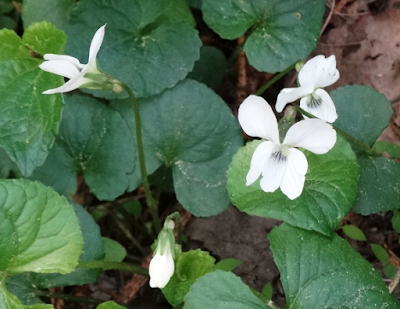This week's bloomlist for Wildflower Island is at the end of the post, and Bonnie's pictures
can be found HERE. Peterson names are used for consistency wherever possible, and comments
and clarifications are welcome in the comments section.
I was away this week and didn't get to see the Phoebe bird, whose family members (?) we often see around the gatehouse. Bonnie got a picture of this one at the bird blind.
Some comments on the Thimbleweed and Canada Anemone, which bloomed this week, a little later than some of the other members of the Buttercup family that we've been seeing for several weeks.
 I just noticed there are two species of what Peterson calls "Thimbleweed." There's apparently been some dispute over the taxonomy based on size of anthers and seed heads, according to Wiki.
I just noticed there are two species of what Peterson calls "Thimbleweed." There's apparently been some dispute over the taxonomy based on size of anthers and seed heads, according to Wiki.Peterson doesn't mention that particular dispute, but differentiates its two kinds by the shape of the bottom of the leaf: rounded in A. virginiana and more wedge-shaped in A. riparia. Based on that description, ours looks more like riparia, but saying that, Wiki mentions that some taxonomists list the A. riparia as A. virginiana var. alba, and others call it A. virginiana var. riparia. Not for me to choose.
 Illinois's picture of the A. virginiana (right), which it calls "Tall Anemone," has the more round-bottomed leaves, the kind that Peterson seems to think separates it from the riparia.
Illinois's picture of the A. virginiana (right), which it calls "Tall Anemone," has the more round-bottomed leaves, the kind that Peterson seems to think separates it from the riparia.Main take-away, though, with the Thimbleweed:
- Sepals not petals,
- The center thimble-like "mound" or "cone" consists of a ring of stamens with yellow or light brown anthers surrounding a green pistillate seedhead that elongates as the sepals drop, eventually turning into a "fluffy mass with numerous dark seeds" that according to Illinois "remains attractive all winter" — when we never get to see them!
- Deeply cut leaves are in a couple of whorls: they're on petioles (stems) and are further cut into shallower lobes.


 The leaf of the Canada Anemone (Anemone canadensis) is deeply cut but sessile, as shown in Andy's Ontario site on the right.
The leaf of the Canada Anemone (Anemone canadensis) is deeply cut but sessile, as shown in Andy's Ontario site on the right.Again, the white sepals are very petal-like, as seen better in the close-up (below) from the Illinois site.

It's fun to compare this bloom with the Multiflora Rose (Rosa multiflora) below, which also just opened this week.
Also in The Woods are another two that are fun to compare. Below on the left are Bonnie's pictures of the pale blue aliens Bugle (Ajuga reptans) and Gill-over-the-ground (Glechoma hederacea). As Mints, they have square stems and lipped blooms, but structurally and otherwise quite different in substantial ways. You can see how the Gill blossom is much more blotchy than the veined, but more uniformly colored Bugle.




Bonnie got a terrific shot of the Cleavers. Note the teeny-weeny flowers and the scratchy leaf edges, which makes it possible to wear a sprig of this thing on your shoulder like a brooch.
We knew at some point the Tulip blooms had to start falling down on the path from the high canopy.
Tulip Tree flowers are heavy nectar producers—probably a necessity to motivate pollinating insects to forage for food so far above their usual ground-level sources of perennials, shrubs, and small ornamental trees.
Tulip Trees are unusual even in needing insect pollinators: Most of the large hardy trees—i.e., anything you'd call a "shade tree"—bloom much earlier in the season, before their leaves have emerged. They just release their pollen right into the air; from on high it's entirely likely to be wafted far and wide by the slightest breeze, so has a good chance of landing on another of that tree's blossoms long before it would hit the ground.
But the Tulip Trees' large leaves would block too much of the breezes to make wind-pollination practical. Worse, the blossoms are marooned high on branches that are (usually) fifty, a hundred, even a hundred and fifty feet higher than most insect pollinators' normal daily foraging. No wonder the flowers are so graphic and colorful, and provide such a big meal to the insects that do make the high-altitude visit. Then they'll remember to come back—and to bring their friends.
I've just bookmarked Louis's website. Looks like a lot of fun.
The bloomlisters didn't detail The Woods this week, but I've given you some possibilities of what went on last year at this time. Next week back to normal.









































